On Thursday January 5, 2023, Brainard Carey interviewed artist Aaon Wilder on Yale Radio about his solo exhibition Omission Rituals at Amos Eno Gallery in Brooklyn, New York. The following text is a transcription of the dialogue between Carey and Wilder edited for clarity and readability with images of the artworks discussed.
Brainard Carey: You’re listening to Yale Radio WYBC. This is Brainard Carey with the lives of the artists, architects, curators, and more. Today on our show I’m talking with Aaron Wilder. Aaron, thanks so much for being with me today!
Aaron Wilder: Thanks for having me!
Brainard Carey: Aaron, we’re talking about your show that’s opening January 5th at Amos Eno Gallery. Let’s jump right into it! Omission Rituals is the title that really caught me and reads kind of what this show is about. Can you tell me a little bit about that title which is really interesting, Omission Rituals?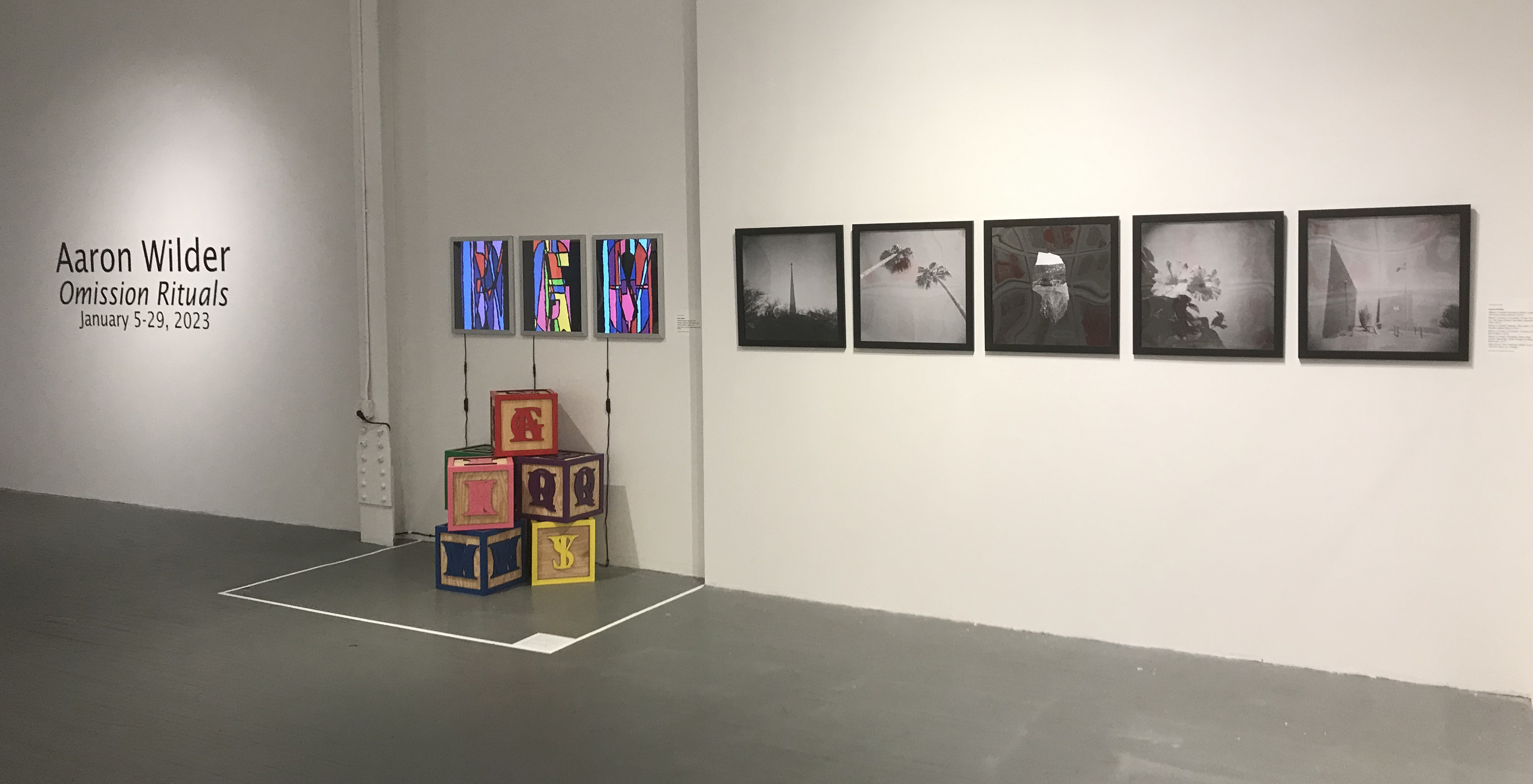 Exhibition documentation of Omission Rituals at Amos Eno Gallery in Brooklyn, New York, Photograph by Aaron Wilder
Exhibition documentation of Omission Rituals at Amos Eno Gallery in Brooklyn, New York, Photograph by Aaron Wilder
Aaron Wilder: Sure, yeah! A lot of my work over the past several years has had to do with things that are missing, either from my own memory or things that I withhold, information that I withhold from someone who is looking at my work. And I didn’t necessarily realize I was doing that, it was kind of subconscious. Through a few conversations with folks over the last year basically, I started to realize that was a connecting thread through pretty much all of my work. Other than it being an investigation of identity and social construction, there was also this idea of things being missing. Despite the ritualistic nature of my practice, very regimented and also looking at similar things multiple times, I was still not really knowing the full picture. So I started to see that as a thread through, like I said, all of my practice, but particularly through the work that I had been wanting to share in this exhibition.
Brainard Carey: The idea that not remembering or omitting certain areas and trying to recover them is a really interesting phenomenon. We all do it to some extent and we have some interesting ways of compensating for that, like embellishing memories or filling in areas that didn’t actually exist. For you, this has been the case for a while in the sense that it seems like you’re talking about memory’s unreliability. Is this something you’ve always thought about, more like a philosophical notion? Or is it also biological?
Aaron Wilder: I’d say it’s biological and social or psychological. What I mean by that is that is particularly when I was in grad school at the San Francisco Art Institute, I had been working on this exploration of things from my personal archive (such as old photographs, letters, things like that) and some of those were photographs my sister took of a car after I had been in a car accident when I was 17 years old. Something that I realized at that point was that due to a concussion I suffered as a part of that car accident, my biological function of remembering has been a little faulty. At that time I had started looking more into this and started investigating more my relationship to my own memory and its unreliability, as you said. The more I looked into it, the more I investigated, the more I realized that social aspects and/or psychological aspects were probably at least as impactful as the car accident on my memory. I grew up in Arizona in a bit of a conservative environment and I was queer and closeted. That also impacted, I think, my inability to remember some things. And some things were stuffed, because I didn’t want to know or didn’t want to deal with them. So, I think there’s multiple layers of these memory challenges that I’ve been investigating.
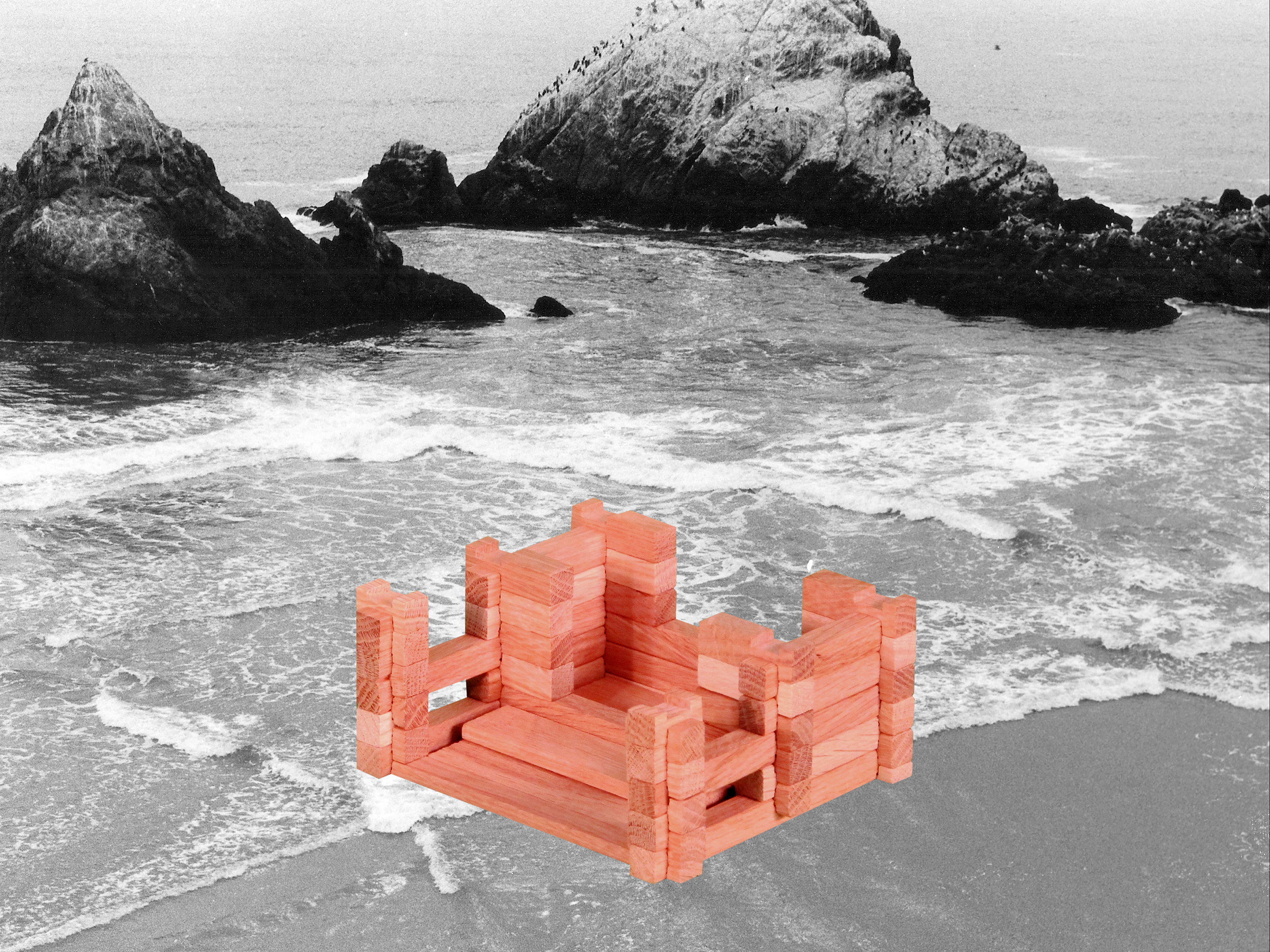
Aaron Wilder, Neither Sand nor Rock, 2022, Digital Photography Collage
Brainard Carey: Thanks for sharing that, it’s really fascinating. Let’s talk about some of the work and how it intersects with that. There’s one image of what looks like a shoreline, a beach, and superimposed on it is building blocks. I can imagine how that relates, but can you tell me a little about that image in the context of what we’re discussing?
Aaron Wilder: Sure, the image you’re referencing is from a project called Neither Sand nor Rock. It’s an investigation of these aspects of social construction and identity and how those relate to a sense of someone’s gender and how they relate to their parents. The series is a juxtaposition of black and white film photographs that I’ve been working on since 2015 and superimposed onto them are these color photographs of building blocks at various stages of completeness or incompleteness. I’ve done them in several iterations. There’re four sub-series of the project that I’ve been working on since 2016. The original works were sequential in order with them either starting from nothing to being a completed house or starting with a completed house and it being deconstructed into nothing. In relation to what we’re talking about as far as that project goes is the process of child rearing that all of us experience. When we’re children we don’t necessarily understand the forces of socialization that are being enacted upon us. This is an attempt to return to that childhood understanding and having psychological or sociological phenomena revealed through play and how that relates to our sense of the world.
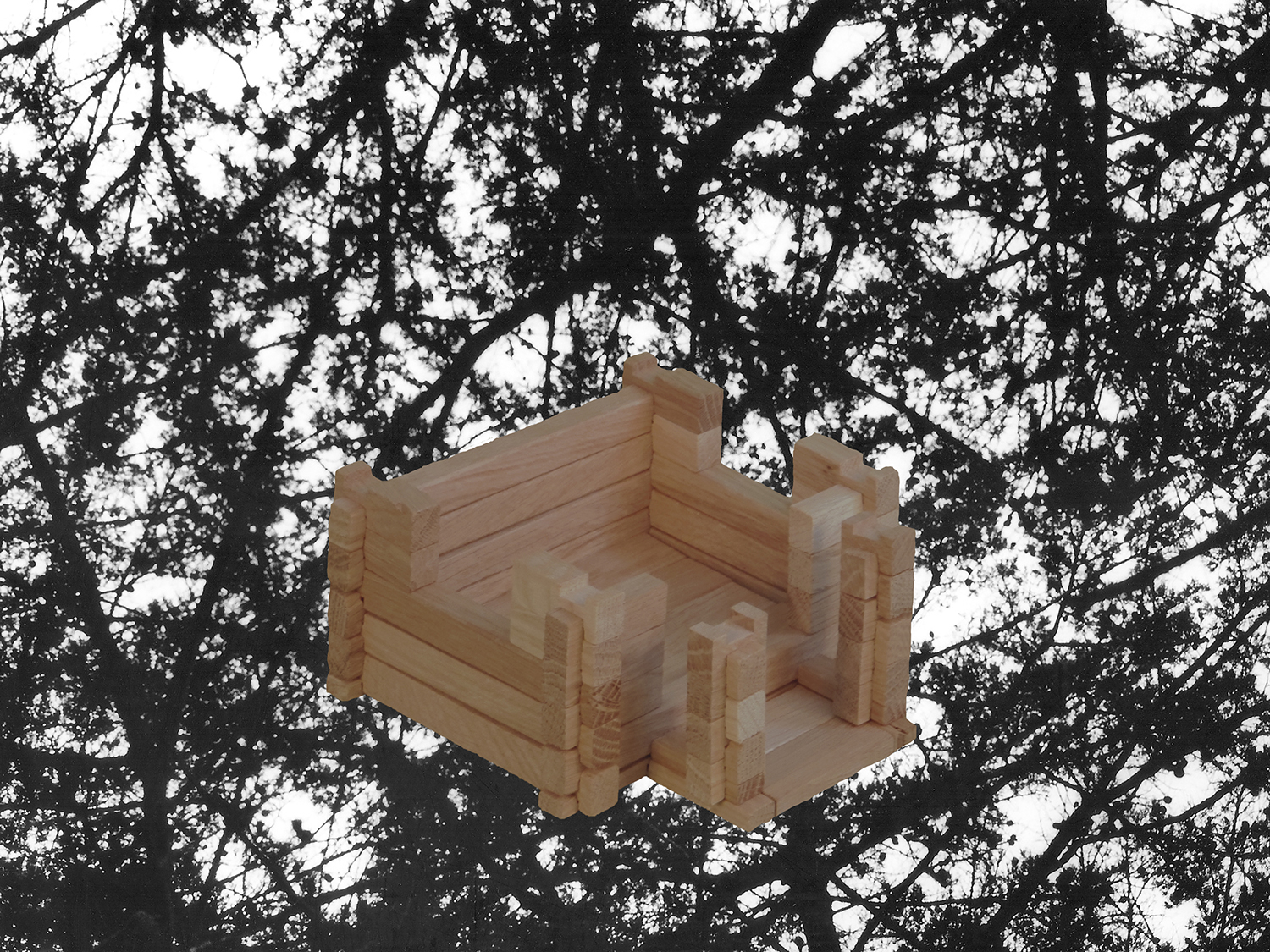
Aaron Wilder, Neither Sand nor Rock, 2016, Digital Photography Collage
Brainard Carey: In that sense of play in the Neither Sand nor Rock series, it seems there are somewhat different titles for them. One of them is Daddy’s House and, like you’re describing, it’s a house that’s half-built and looks like it’s made out of Lincoln Logs. I just recently found out that Frank Lloyd Wright’s son invented Lincoln Logs. It’s kind of amazing that a memory so much of us may have with that toy. In this uncompleted house called Daddy’s House, which is part of this series, is that also referencing part of what you’re saying? It’s very specific, we’re talking about Daddy’s House. It’s something that sounds like what a child would say and it’s something a child would build. But the image behind the house is an image of trees, where this house couldn’t possibly be built, just like the other one being on the beach. Is the displacement of that also what you’re saying? It’s partly built, missing parts, but the images their contrasted with is also what I’m asking about.
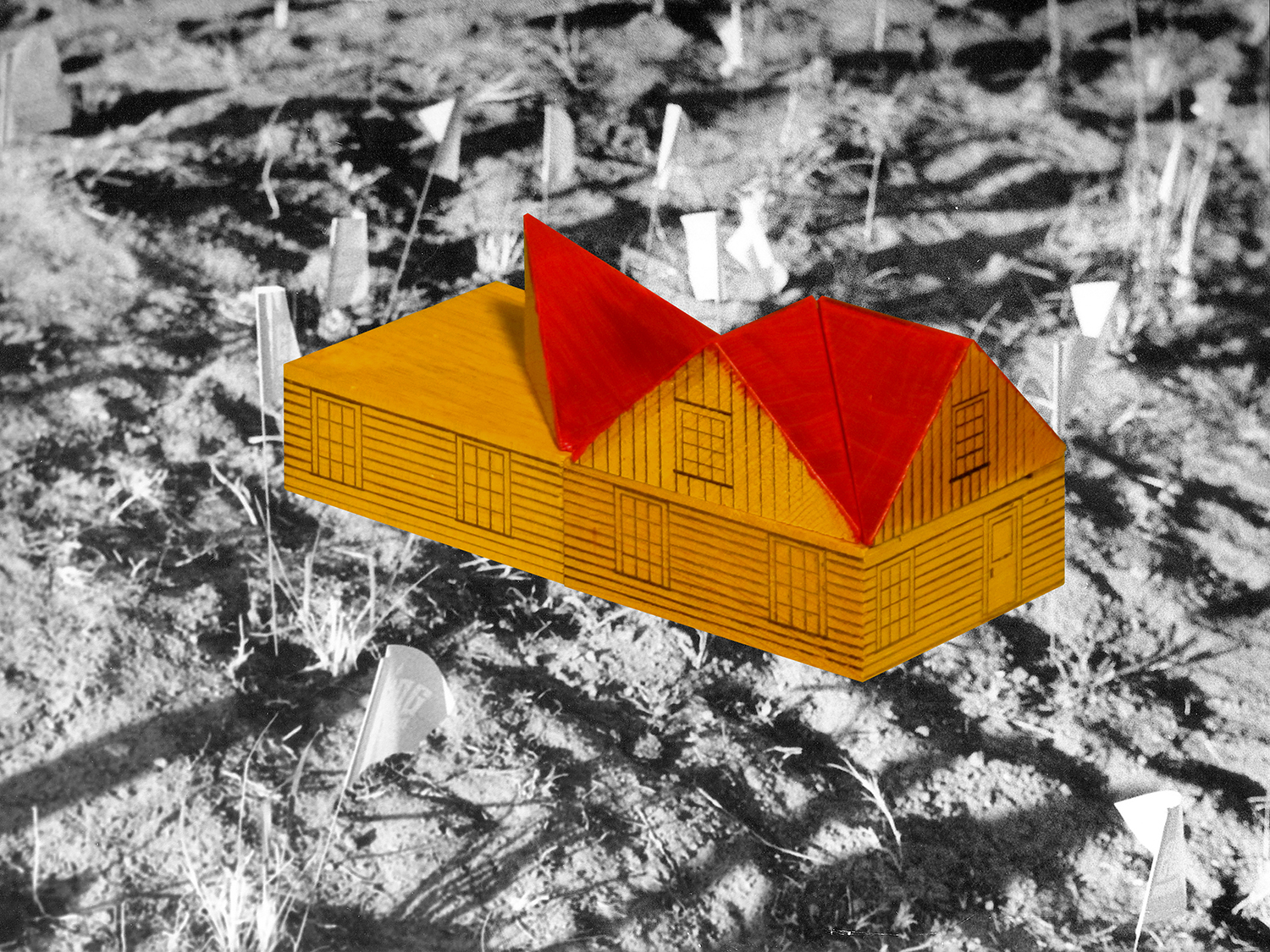
Aaron Wilder, Neither Sand nor Rock, 2018, Digital Photography Collage
Aaron Wilder: What you’re referencing is the partially built or partially deconstructed toy houses are floating above landscape photographs and the whole series is looking at the impossibility of these partially constructed houses. How it’s positioned on the background photograph is impossible, it’s not something that is meant to look realistic. It’s a forced placement of this idea of a house or home in these different types of backgrounds. The black and white photographs are from a number of completely different projects that I had mostly been working on in 2015 and a little later. I was looking at these sequences of Mommy’s House and Daddy’s House in divergent backgrounds. The ones referring to Daddy’s House are in more rustic landscapes, like farmland or ocean landscapes. Then, the ones related to Mommy’s House would be more urban, so they’re either in places that have already been under construction in an urban area or they’re in a place like this one background has these little flags in the ground that are basically marking landscape to be removed for housing or some other sort of building. Those different sequences are relating to either an urban or a rural landscape not necessarily as a dichotomy, but perhaps opposite ends of a spectrum and that also relates to the title of the project, Neither Sand nor Rock, which is a meditation on the children’s Sunday school song The Wise Man Built His House Upon the Rock. That song presents a metaphor for Christianity and all that goes along with that.
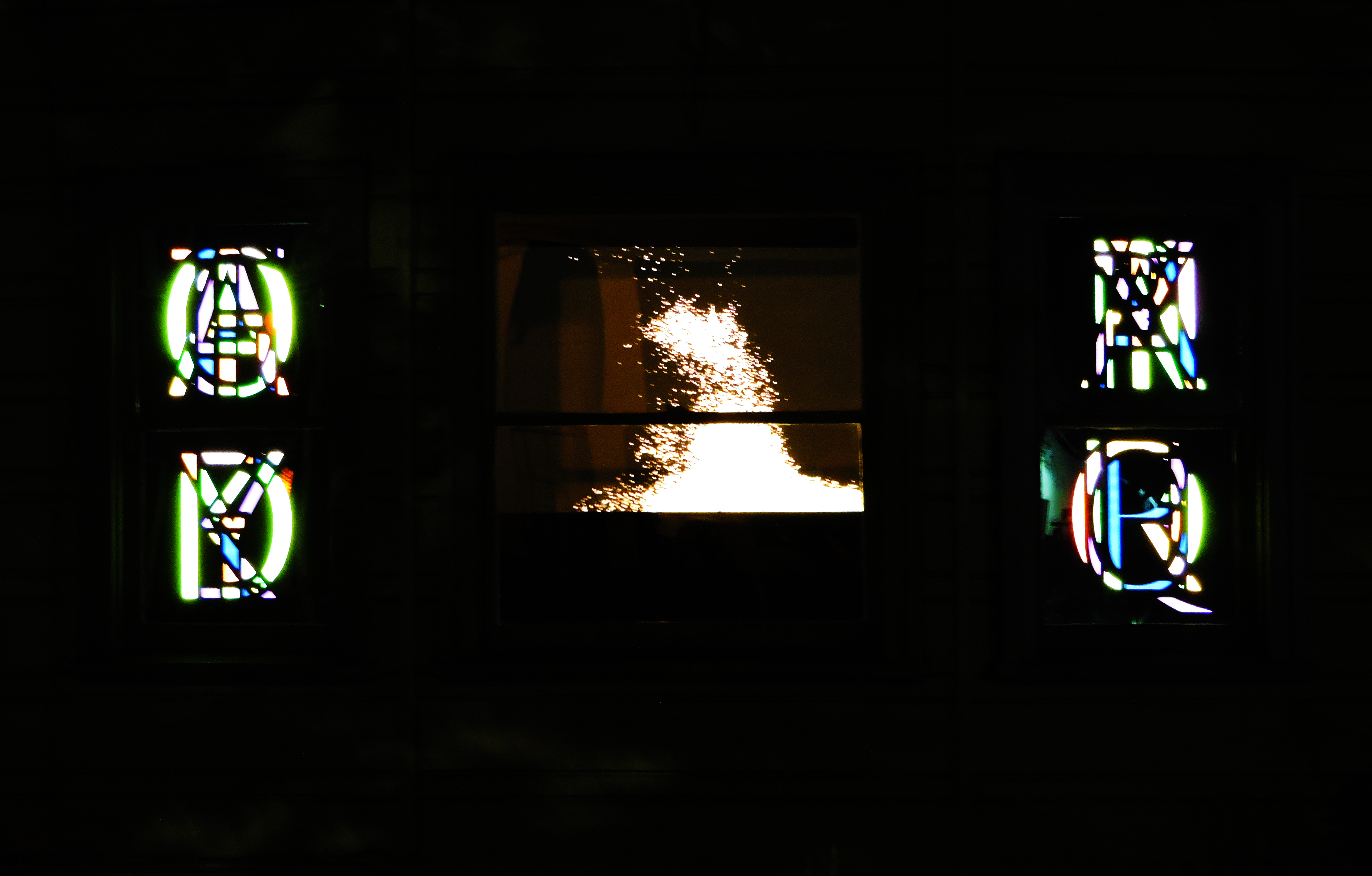
Exhibition documentation of Expletive Chapel: Lavender Heights at the InsideOut in Sacramento, California in 2019, Photograph by Aaron Wilder
Brainard Carey: In speaking of Christianity, there are other images you’ve made previously that were in a chapel. Tell me a little about those. In some ways, I imagine that is about the process, as you were saying, about being queer and also struggling with oppressive structures that are schooling you in a completely different way, in a way that is kind of the antithesis of freedom. But maybe I’m reading that into it? They’re beautiful images that the idea of an explicative chapel in interesting, because it’s kind of the opposite of what you’d imagine in a chapel. But it’s also a push-back in a way, a critique, and a painful memory perhaps?
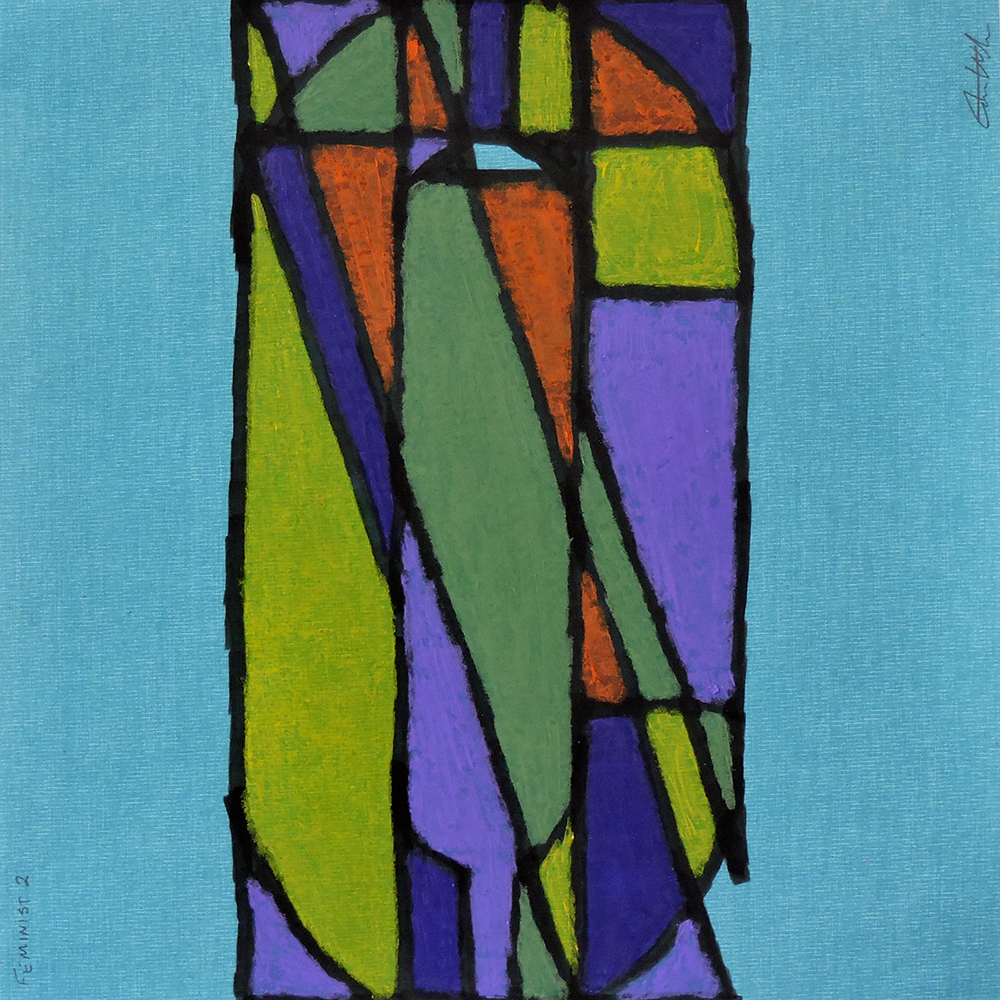
Aaron Wilder, Expletive: Feminist 2, 2015, Mixed Media Drawing on Paper
Aaron Wilder: The project you’re referencing, Expletive, is something that evolved over a long period of time and manifested itself in different media. It started out as these 12x12” square drawings. I was taking derogatory slurs and deconstructing them or attempting to remove their power by obscuring them. I took many different derogatory slurs and stacked the letters on top of each other using stencils so you couldn’t actually read what the word is. The result looks like a geometric jumble of shapes. That was kind of exploratory for me to try and disempower these really negative words. The drawings didn’t really feel like the ultimate manifestation of the project, so I kept working on the idea. Sorry, I forgot to mention that four of those drawings are exhibited in Omission Rituals at Amos Eno Gallery. I started making these sculptural cubes that are referencing children’s alphabet blocks, but instead of being small they’re a cubic foot each, so they’re much larger. Instead of having individual letters on each side they have one of these deconstructed slurs on their six sides. The series of seven sculptures I made are also included in Omission Rituals. The other thing I’ll mention that is more specifically related to religion or Christianity are light boxes designed to look like stained glass windows. Instead of the light coming from outside in, it’s coming from inside radiating out. The light is illuminating these deconstructed slurs. I created these prototypes for what I was referring to as reversed stained glass windows out of LED frames. They were just meant to be prototypes to see how it would look. The prototypes themselves didn’t seem to be the ultimate manifestation of the project either. In 2019, I had an opportunity to do an installation at the InsideOut in Sacramento, California. The InsideOut is in a historically queer neighborhood called Lavender Heights. I used the windows of the space to create these reversed stained glass windows. I converted four of the windows into these deconstructed slurs that had light shooting out into the street. And that, to me, seemed to be the ultimate manifestation of the project. I mention that because you were asking about religion or Christianity and how it relates to these deconstructed slurs. In my experience being brought up in a Southern Baptist environment while being secretly queer, there was a disconnect in the moralizing nature of the religious environment I was within and the very negative aspects of internalized homophobia and actual hurtful things people say in many of these extremely religious environments. And I’ll mention that the installation I did in Sacramento in 2019 was titled Expletive Chapel: Lavender Heights. The space is a very strange art space, basically a bay window that visitors can’t actually go in, they can just see in the windows from the street. The large window in the middle was meant to be a portal people could look into and see a reliquary of queer artifacts. I interviewed some people that are a part of or somehow related to the queer community in Sacramento and I also did some research at the Lavender library, which is down the street from the InsideOut. I had these objects related to individual stories about their experience growing up either gay or trans and I painted the objects lavender and put them in the space as this revered reliquary that people could look into and see these different objects. The side windows, as I mentioned, had light coming from inside out through the deconstructed slurs. There was a lot I was thinking about related to the name InsideOut, but also just the space. The prototypes, as I mentioned, were these LED frames. I never actually exhibited those before, they were just meant to be tests. But I decided to include them in this show, Omission Rituals, because it seemed appropriate to show them at some point, so they are on display as well with the blocks.
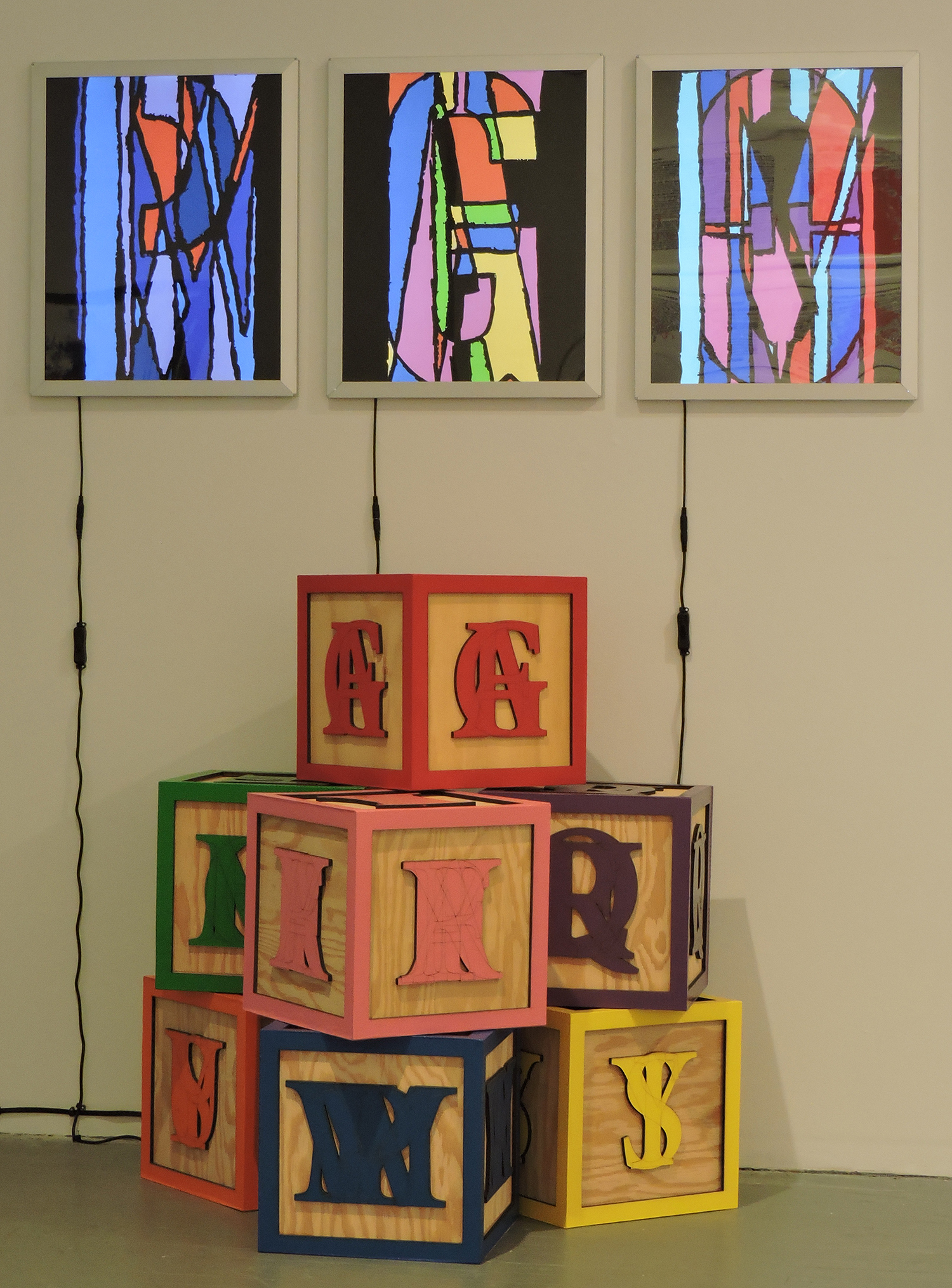
Exhibition documentation of Omission Rituals at Amos Eno Gallery in Brooklyn, New York, Photograph by Aaron Wilder
Brainard Carey: I’m so glad we’re talking about that. I wish you well with Omission Rituals. For all those listening there are links here to come see it, it’s running through January 29, 2023. I want to ask you a little bit more about your curatorial practice, because you’re, of course, an artist and that’s what we’re talking about, but you’re also a curator at the Roswell Museum. Is that correct?
Aaron Wilder: Yes.
Brainard Carey: Tell me a little bit about that. How did that happen and what do you do there? I read about the museum and it seems like it’s an unusual one in terms of its federal creation. Tell me about your work there.
Aaron Wilder: Sure, my position at the Roswell Museum is Curator of Collections and Exhibitions and I started there just a little over a year ago. My curatorial practice, I always think of it, as an extension of my artistic practice. Instead of making my own work, I am exercising artistic practice through the work of others. That is either working with contemporary artists or works in the museum’s collection. My curatorial practice originated in 2009. I had my own art space in downtown Phoenix in an artist collective called Holgas that, sadly, no longer exists. I had a store-front space in which I intended to exhibit my own work and I did, but it was also the beginning of collaborating with other artists and showing the work of other artists along with mine in that space. I got really interested in how work of other artists could say things that my work can’t. I thought that was really a powerful sum of different parts. I continued being interested in that and when I was in my MFA program at the San Francisco Art Institute I took every opportunity I could to work with other artists, whether that was collaborating on an actual artistic object or a series of photographs, or curating other peoples’ works together without my work. I continued to have different curatorial experiences here and there and I started working more and more as a curator as far as a paid job goes. The pandemic threw a bunch of wrenches (not just one wrench, but a whole toolbox!) into that process of wanting to be a curator in addition to my artistic practice or as a parallel to my artistic works. The Roswell Museum opportunity arose at a time when I was questioning whether or not I would continue in the curatorial field and I was given this amazing opportunity. It’s been a really wonderful experience and learning experience, not just being new to Roswell, New Mexico, but also being embedded in the very vibrant artistic community in Roswell. There’s a very well-established residency program there that’s been around since 1967. It’s incredible working with the resident artists and also who are referred to as the alumni of the residency program who have stayed in Roswell and have built a fantastic community there.
Brainard Carey: That’s really exciting and I’m glad you shared that with me. Before we go I want to ask you one more question. A little off-topic, but I’m always curious what everyone’s reading. What are you reading at the moment?
Aaron Wilder: Well, my reading has been a little disrupted over the past year. During the early part of the pandemic I lived (and this is a whole other side story that we don’t have time to talk about) in Chicago for a year and a half and I actually read a lot in that time. But since then, both because of preparing for this exhibition in Brooklyn and the reality of being a curator at a museum is very engrossing. It’s intellectual work and it’s also very time consuming. Everything I’ve been reading have been related to the exhibitions I was curating for the most part and not really reading for my own personal sense. The book I have started reading over the last month or so is called For Your Own Good which is a book by Alice Miller who was a Swiss psychologist. It’s a book that’s basically about the socialization process of child rearing and the impact of that. I’ve read a lot of Alice Miller’s books both for me personally (as far as understanding my own psychological processes goes) and, even more so, how those child rearing practices manifest themselves societally and how that may or may not impact my curatorial work and just overall education about the world.
Brainard Carey: Aaron, thanks so much for sharing that with me as well as this discussion on your work. I want to wish you well in this coming show and I hope some listeners can come see it, there’s links in here to do so. Aaron, thanks so much again for being with me today!
Aaron Wilder: Thanks so much for inviting me, I appreciate it!